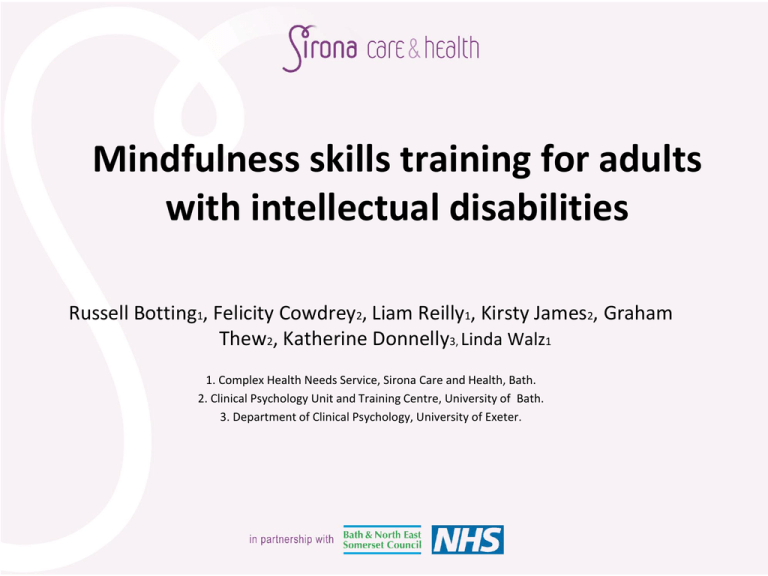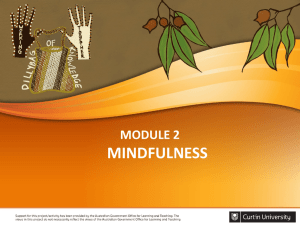Mindfulness skills training for adults with intellectual disabilities
advertisement

Mindfulness skills training for adults with intellectual disabilities Russell Botting1, Felicity Cowdrey2, Liam Reilly1, Kirsty James2, Graham Thew2, Katherine Donnelly3, Linda Walz1 1. Complex Health Needs Service, Sirona Care and Health, Bath. 2. Clinical Psychology Unit and Training Centre, University of Bath. 3. Department of Clinical Psychology, University of Exeter. What we will cover: • Mindfulness – What is it? – Evidence-base for mindfulness – Mindfulness in ID populations • • • • • • Study 1: Pilot study of mindfulness skills training (Group 1) Study 2: Evaluation of mindfulness skills training (Group 2 and 3) Discussion and Conclusion Limitations Our reflections Future directions Mindfulness • Mindfulness means paying attention in a particular way… – on purpose – in the present moment – non-judgementally • Cultivated through a range of meditative practices Jon Kabat-Zinn (1990) Evidence-base • Mindfulness increasingly popular approach • Emerging evidence-base for its use in a number of physical health problems (e.g. cancer, aids, pain) and mental health problems (e.g. stress, anxiety, depression)(for a review see Khoury et al., 2013) • Forms part of DBT, ACT, MBCT and MBSR • MBCT recommended by NICE (2009) for relapse prevention in depression Mindfulness in adults with ID? • Adults with ID experience higher rates of mental and physical health problems compared to those without ID (Cooper et al., 2007) • Adults with ID should have access to the same evidence-based treatments as those without ID (Valuing People, DoH, 2001) • Few studies have reported on the use of mindfulness in ID Chapman et al., (2013) review – 11 studies – Most commonly taught meditation practice was Soles of the Feet – Mindfulness generally provided to individuals, rather than in groups – Length & manner of training varied – All studies found improvements after mindfulness training e.g. reduced aggression/sexual arousal/weight Chapman et al., (2013) review – Participant feedback suggests: • May initially find practice difficult to understand as not easy to remember event • Repeated practice, use of role-play and adding stimulus to feet helped • Individuals valued learning to control their own feelings rather than being told to calm down by others, and found this reinforcing Pilot study: Are mindfulness practices, taught in a group format, acceptable and useful for adults with ID? (Donnelly, James and Walz, In press) Preparation • • • • Adapting practices e.g. wording, type of practice Group location? Involvement of support workers? Length of group? • Letter & information sheet • Initial meeting about group • Evaluation - Coping measure, interviews, feedback The pilot group • Four-week group run for an hour • Four participants (half female) • Recruited from CLDT due to difficulties coping with emotions such anxiety or anger • Two participants accompanied by their support worker / PA • Facilitated by clinical psychology trainee (KJ) and volunteer Session structure • Orientation – introductions, session plan, group rules • Introductory task – shifting focus of attention • • • • Mindfulness training – Soles of the feet practice Group discussion & feedback Discussion about home practice Session feedback questionnaire Mindfulness group feedback questionnaire Participant feedback • Helpful aspects: – “The mindfulness practices” – “Learning new skills” – “Focusing on things to bring my mind back from wondering” – “Learnt to think about today not yesterday” – “Sharing with the rest of the group” – “Making new friends” – “Being with the group” • Least helpful aspects: – “It did bring up the past” – “I’m not sure about the feet one” Modifications based on feedback – – – – Six-week group Focus on the palms of the hands or soles of the feet Add in another practice Add in quantitative measure for evaluation • Modified Five Factor Mindfulness Questionnaire (FFMQ-m) • One item from each of the five factors: – – – – – non-reactivity to inner experience observing thoughts and feelings acting with awareness describing/labelling with words non-judging of experience Groups 2 and 3: Is a modified protocol acceptable and useful for adults with ID and does the group program lead to an increase in self-reported mindfulness? Groups 2 and 3 • Two six-week courses each session 60-90 minutes • Total of 11 participants with ID – group 2, n=5 – group 3, n= 6 • Facilitated by trainee clinical psychologist and assistant psychologist • Feedback sheet after each session • Home practice CD (Singh et al., 2003 script) Session structure Session 1 What is mindfulness? Shifting attention Soles of the feet / palms of hands practice Introduction to home practice Session feedback Session 4 Session 2 What are negative thoughts and worries? Shifting attention Soles of the feet / palms of the hands Awareness of breathing Feedback on homework Home practice Session feedback Session 5 Session 3 Switching attention Soles of the feet / palms practice Guiding thought back to the present Feedback on homework Home practice Session feedback Session 6 Switching attention Soles of the feet / palms practice Using practices when feeling anxious Group 3 only Introduction to three minute breathing space Feedback on homework Home practice Session feedback Switching attention Soles of the feet practice / palms practice Group 2 only Introduction to three minute breathing space Group 3 only Practice of three minute breathing space Group 3 only Introduction to mindful eating Feedback on homework Home practice Session feedback Switching attention Soles of the feet / palms practice Three minute breathing space Group 3 only Mindful eating Using mindfulness after the group Feedback on the group RESULTS Quantitative results • No significant difference between the pre-group and post-group scores on four of the five factors of the FFMQ-m (p> .05) • Scores on the describing item (“I'm good at describing how I feel”) were significantly higher post-group than the pre-group scores (p ≤ .05) Themes from qualitative feedback • Mindful self-reflection – – – – “Today and now is what matters” “Try not to worry too much” “Realising how distracted I am” “I like my thoughts today, I've got a lot on my mind this week” • Noticing improvements – “It is getting easier I think” – “The session has been very helpful for me. I find it easy now we do we do it a bit longer” • Social aspects of the group – “Helpful to talk to other people” • Enjoyment of mindfulness practices – “I liked the three minute practice and I like the stone” – “Focusing on the soles of my feet” [Noted as something liked about the group] Suggested improvements • Environmental – “Noises in the car park outside. Switching attention was not as easy” • Session / practice length – – – – “The mindfulness [practice] was too long” “Less time doing the soles of the feet activity” “Not long enough” “More sessions” • Types of practices – “Maybe change an activity” DISCUSSION • Six-week mindfulness group significantly improved participants ability to describe their feelings • Participants with ID reported a number of subjective benefits of mindfulness skills training • The social aspect of the group intervention is experienced as positive • Similar themes to those extracted from research in non-ID samples Conclusions • Group mindfulness interventions are acceptable and useful for adults with ID • Mindfulness can be adapted for adults with ID • Group format particularly well suited to adults with ID • Mindfulness may helps clients with ID feel more able to identify and express emotions Limitations • Small sample size • Use of unvalidated measures for evaluation with no previous testing on ID • High participant drop-out • No control condition • No long term follow-up Our reflections • Variation in personalities and needs influencing the group process • Communicating abstract concepts • Home practice - Was more emphasis needed on what this was for? What more support needed ? Future directions • Develop and validate a measure of mindfulness suitable for adults with ID • Measure change in reason for referral (for example, anxiety, rumination) • Add in additional practices earlier on (for example, mindful eating, breathing space) • Involve support network more - staff training • Extend the number of sessions to 8 • Conduct follow-up • Paper in preparation…. Questions… Contact: linda.walz@sirona-cic.org.uk Key references • Khoury, B., Lecomte, T., Fortin, G., Masse, M., Therien, P., Bouchard, V., Chapleau, M. and Paquin, K et al. (2013). Mindfulnessbased therapy: A comprehensive meta-analysis. Clinical Psychology Review 33(6), 763–71. • Robertson, B. (2010). The adaptation and application of mindfulness-based psychotherapeutic practices for individuals with intellectual disabilities. In R. Fletcher (Ed.) Psychotherapy for individuals with intellectual disability. Kingston, NY: NADD. • Singh, N. N., Lancioni, G.E., Winston, A. S. W., Adkins, A. D., Singh, J. and Singh, A. N. (2007). Mindfulness training assists individuals with moderate mental retardation to maintain their community placements. Behaviour Modification, 31(6), pp. 800-814. • Singh, N. N., Lancioni, G.E., Winston, A. S. W., Singh, A. N., Adkins, A. D. and Singh, J. (2008). Clinical and benefit-cost outcome of teaching a mindfulness-based procedure to adult offenders with intellectual disabilities. Behaviour Modification, 32(5), pp. 622-637. • Uma, K., Nagarathna, R., Nagendra, H. R., Vaidehi, S. and Seethalakshmi, R. (1989). The integrated approach of Yoga, a therapeutic tool for mentally retarded children: a one-year controlled study. Journal of Mental Deficiency Research, 33, pp. 415-421. • Donnelly, K., James, K., and Walz, L. Group-based mindfulness practice training for individuals with a learning difficulty: A pilot study. Clinical Psychology Forum (In press) • Chapman et al., (2013) The use of mindfulness with people with intellectual disabilities: A systematic review and narrative analysis. Mindfulness, 4, 179-189.





